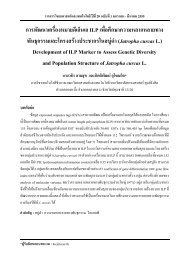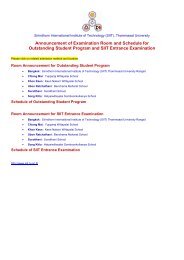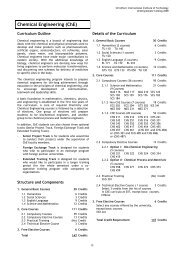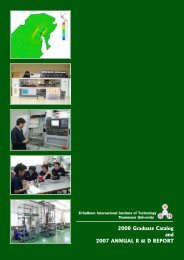<strong>10</strong> <strong>Years</strong> <strong>of</strong> <strong>International</strong> Cooperation: FTI, Nippon Keidanren and TU<strong>SIIT</strong> <strong>Commemorative</strong> <strong>Publication</strong>, 2002node are calculated during forward propagation, basedon branch currents and weighted average <strong>of</strong> calculatedand measured loads at each node. Voltage at each node iscomputed and the test for convergence is performed. Theabsolute errors <strong>of</strong> measured and calculated values <strong>of</strong> realand reactive power flows and injection are alsoperformed. Computation <strong>of</strong> branch losses, total losses,and quantity <strong>of</strong> unbalance in current and voltage is doneonce the program converges.Ordering <strong>of</strong> node numbers to generate properparent-child relation based on the networkFigure 1: Basic block diagram <strong>of</strong> state estimator.3.2 Iterative SchemeSelection <strong>of</strong> pseudo measurements, filling<strong>of</strong> missing data, providing appropriateweightageBackward propagation to calculate branchcurrents, branch flows and average <strong>of</strong> calculatedand measured branch flows providing weightsCompute errors between measured and estimatedvalues, detect bad measurements, replace by pseudo orcalculated values in the place <strong>of</strong> bad measurementsForward propagation to calculate node voltages, load ateach node based on branch currents and weightedaverage <strong>of</strong> calculated and measured loads at each nodeNoTest for convergenceYesComputation <strong>of</strong> branch losses, totallosses, quantity <strong>of</strong> unbalance etcInitially the node voltage magnitudes are set to themeasured voltages if they are available. Otherwisevoltage magnitudes are set to 1.0 pu and voltage anglesare set to 0.0, -120, 120 degrees in phase A, phase B,phase C, respectively and also all the branch currents,powers (complex) are set to (0.0,0.0) pu. V (1) is thesource node and its value is assumed to be known. Alsoits angle δ=0 (taken as reference).3.3 Backward PropagationThe purpose <strong>of</strong> the backward propagation is tocalculate branch currents and then the branch flows ineach section. During backward propagation, voltagevalues are held constant and information about branchcurrents and averaged flows are transmitted backwardalong the feeder using backward walk. During thispropagation the load current is calculated assuming theload as the demand measurement in each node. In theexample network <strong>of</strong> Figure 2, the backwardpropagation starts from branch 8-5 and proceeds alongthe path 7-5, 6-4, 5-4, 4-2, 3-2 and 2-1. Table 1 givesthe Parent child relationship.2(2)4(1)(7)1 6(3) (4)25(2) Branch numberNode numberFigure 2: Sample feeder with new node numbers.Parent node 1 2 2 4 4 5 5Child node 2 3 4 5 6 7 8Table 1: Parent child relationship.3.4 Forward PropagationThe purpose <strong>of</strong> forward propagation is to calculate thevoltage and load at each node starting from the sourcenode <strong>of</strong> the feeder. The feeder substation source voltageis set to its measured value. During forward propagation,the branch currents are calculated based on the averagedflows, are used to calculate the nodal voltages and hencethe loads at each node.3.5 Convergence CriteriaThe steps outlined in backward and forwardpropagation are followed during each iteration <strong>of</strong>voltage computations. The convergence criterion isthat, voltage magnitudes <strong>of</strong> real and imaginary parts <strong>of</strong>complex voltage at each node are compared with itsprevious iteration values. Therefore the voltagemismatch for j th node during k th iteration is given byfollowing equations.∆V k (j) = V k (j)- V k-1 (j) for a,b, and c phasesReal ⎟ (∆V(j))⎟ < eps, j ε all the nodesImag ⎟ (∆V(j))⎟ < eps, j ε all the nodes3If both the equations are satisfied the iterative process iscompleted. Once the voltages are estimated all the branchcurrents and the real and reactive power flows, losses,effect <strong>of</strong> unbalanced can be calculated. In addition tovoltage, the absolute errors <strong>of</strong> measured and calculatedvalues <strong>of</strong> real and reactive power flows, real and reactivepower injection in branch are checked.Change in the supply frequency, voltage and waveformoutside the normal range gives rise to power qualityproblems. Power quality problems solved at the service7(5)(6)824
<strong>10</strong> <strong>Years</strong> <strong>of</strong> <strong>International</strong> Cooperation: FTI, Nippon Keidanren and TU<strong>SIIT</strong> <strong>Commemorative</strong> <strong>Publication</strong>, 2002entrance are economical. DA is the best solution tomonitor and control these parameters.4. Developed Algorithms for DistributionAutomation Application FunctionsDistribution networks are fed from alternativesources/substation feed-points for a reliable supply <strong>of</strong>power to consumers. In real time environmentdistribution network configuration changes dynamicallydue to switching. Real time network model depends onthe correctness <strong>of</strong> the network topology determined fromthe telemetered data. This research presents a networktopology processing (NTP) algorithm suitable fordistribution networks. A simple data structure fordistribution network connectivity information storage isproposed for efficient implementation <strong>of</strong> networktopology processing. The developed method has beentested on a large practical distribution network withseveral feeders (Thukaram et al, 1999a).An efficient load flow solution technique is required as apart <strong>of</strong> the distribution automation system for takingvarious control and operation decisions. A robust threephasepower flow algorithm is presented (Thukaram etal, 1999b). This method exploits the radial nature <strong>of</strong> thenetwork and uses forward and backward propagationtechnique to calculate branch currents and node voltages.The proposed method considers all aspects <strong>of</strong> threephasemodeling <strong>of</strong> branches and detailed load modeling.The merits <strong>of</strong> the method are, guaranteed convergenceeven for heavily loaded network with poor voltagepr<strong>of</strong>ile. The method has been tested on practicaldistribution systems with many feeders emanating fromthe grid substation with large number <strong>of</strong> nodes andbranches.The application <strong>of</strong> the proposed method was alsoextended to find optimum location for reactive powercompensation and network reconfiguration for planningand day-to-day operation <strong>of</strong> distribution networks(Jerome, 2001a).An efficient and robust state estimation solutionalgorithm has been presented (Thukaram et al, 1998).The algorithm is based on forward and backwardpropagation. The new methodology has been tested onsample systems to analyze distribution networks havinghigher R/X ratio <strong>of</strong> lines. The proposed method hasworked well regardless <strong>of</strong> the feeder r/x ratio while theconventional WLS method failed to give a solution inmost <strong>of</strong> the cases. Distribution state estimators (DSE)will also play a critical role in distribution managementsystem to estimate those real-time system states whichare unable to be obtained from the limited measurementinstruments in the distribution network. The success <strong>of</strong>DAS largely depends on the availability <strong>of</strong> reliabledatabase <strong>of</strong> the control center and thus requires anefficient state estimation (SE) solution technique. Themethod estimates the line flows, node voltages and loadsat each node based on the measured quantities.Real-time control <strong>of</strong> the distribution system requires anestimate <strong>of</strong> the system states. Distribution, state estimatorestimates the current operating status <strong>of</strong> a distributionfeeder by using limited real-time SCADA data andhistorical load data. In modern energy managementsystem (EMS), a state estimation (SE) program processesa set <strong>of</strong> raw measurement data and provides a real-timeload flow solution which is the basis <strong>of</strong> the advancedfunction for system security monitoring and control. SEis based on the mathematical relations between thesystem state variables (node magnitudes and angles) andthe measurements. As the automation <strong>of</strong> powerdistribution progresses, it will become necessary to applystate estimation techniques as part <strong>of</strong> the DAS. SEsuitable for unbalanced three-phase radial distributionnetworks has been developed and tested on practicaldistribution network and presented (Thukaram et al,2000a).The SE cannot be executed without an adequate number<strong>of</strong> measurements. The extension <strong>of</strong> the method to thenetwork observability analysis and bad data detection isalso discussed. The proposed method has been tested ona few sample and practical distribution networks withsimulated data for real-time measurements (Jerome,2001b).Unlike in transmission system, distribution networks maynot be provided with protective devices or circuitbreakers in each branch <strong>of</strong> the feeder. Although RTUsmay be installed at various nodes/branches <strong>of</strong> the feederfor various measurements, circuit breakers may be onlyat the substation/switching station in the network. For anyfault in the feeder, a large part <strong>of</strong> the feeder, may beisolated depending on the circuit breaker installation. Forthe purpose <strong>of</strong> speedy repair work and maintenance, it isimportant to find the exact fault location and type <strong>of</strong>fault. An algorithmic approach for finding the locationand type <strong>of</strong> fault based on the three phase measurementsobtained for state estimation is presented. Results <strong>of</strong> thesimulated fault conditions on practical distributionsystems are also presented (Thukaram et al, 2000b).The advent and widespread use <strong>of</strong> high-powersemiconductor switches at the utilization, distribution andtransmission levels have made non-sinusoidal loadcurrents more common. Power quality engineering hasnow become a subject <strong>of</strong> more focused interest.Distribution Automation can improve the quality <strong>of</strong>power (Jerome, 2001c). When wave shapes are irregular,voltages are poorly regulated, harmonics and flicker arepresent, and then power utilization will be degraded.Power Quality enhancement trends has become a timelytopic in power engineering (Jerome, 2002)25
- Page 2 and 3:
!" Years of International Cooperati
- Page 5 and 6:
1993: Her Royal HighnessPrincess Ma
- Page 7 and 8:
!"#$%&'(#)*#+,-%',&-.),&/#0))1%'&-.
- Page 9 and 10: !"#$%&'(#)*#+,-%',&-.),&/#0))1%'&-.
- Page 11 and 12: !"#$%&'(#)*#+,-%',&-.),&/#0))1%'&-.
- Page 13 and 14: !"#$%&'(#)*#+,-%',&-.),&/#0))1%'&-.
- Page 15 and 16: !!!"#$%&'(#)*#+,-%',&-.),&/#0))1%'&
- Page 17 and 18: !!!"#$%&'(#)*#+,-%',&-.),&/#0))1%'&
- Page 19 and 20: !!"#$%&'(#)*#+,-%',&-.),&/#0))1%'&-
- Page 21 and 22: !!"#$%&'(#)*#+,-%',&-.),&/#0))1%'&-
- Page 23 and 24: "#!$%&'(!)*!+,-%',&-.),&/!0))1%'&-.
- Page 25 and 26: !!"#$%&'(#)*#+,-%',&-.),&/#0))1%'&-
- Page 27 and 28: !"#$%&'(#)*#+,-%',&-.),&/#0))1%'&-.
- Page 29 and 30: !"#$%&'(#)*#+,-%',&-.),&/#0))1%'&-.
- Page 31 and 32: !"#$%&'(#)*#+,-%',&-.),&/#0))1%'&-.
- Page 33 and 34: !"#$%&'(#)*#+,-%',&-.),&/#0))1%'&-.
- Page 35 and 36: !"#$%&'(#)*#+,-%',&-.),&/#0))1%'&-.
- Page 37 and 38: 10 Years of International Cooperati
- Page 39 and 40: 10 Years of International Cooperati
- Page 41 and 42: 10 Years of International Cooperati
- Page 43 and 44: 10 Years of International Cooperati
- Page 45 and 46: 10 Years of International Cooperati
- Page 47 and 48: 10 Years of International Cooperati
- Page 49 and 50: 10 Years of International Cooperati
- Page 51 and 52: 10 Years of International Cooperati
- Page 53 and 54: 10 Years of International Cooperati
- Page 55 and 56: 10 Years of International Cooperati
- Page 57 and 58: 10 Years of International Cooperati
- Page 59: 10 Years of International Cooperati
- Page 63 and 64: 10 Years of International Cooperati
- Page 65 and 66: !!"#$%&'(#)*#+,-%',&-.),&/#0))1%'&-
- Page 67 and 68: !!"#$%&'(#)*#+,-%',&-.),&/#0))1%'&-
- Page 69 and 70: #!"#$%&'(#)*#+,-%',&-.),&/#0))1%'&-
- Page 71 and 72: #!"#$%&'(#)*#+,-%',&-.),&/#0))1%'&-
- Page 73 and 74: #!"#$%&'(#)*#+,-%',&-.),&/#0))1%'&-
- Page 75 and 76: 10 Years of International Cooperati
- Page 77 and 78: 10 Years of International Cooperati
- Page 79 and 80: 10 Years of International Cooperati
- Page 81 and 82: 10 Years of International Cooperati
- Page 83 and 84: 10 Years of International Cooperati
- Page 85 and 86: 10 Years of International Cooperati
- Page 87 and 88: !!"#$%&'(#)*#+,-%',&-.),&/#0))1%'&-
- Page 89 and 90: !!!"#$%&'(#)*#+,-%',&-.),&/#0))1%'&
- Page 91 and 92: !"#!$%&'(!)*!+,-%',&-.),&/!0))1%'&-
- Page 93 and 94: !"#!$%&'(!)*!+,-%',&-.),&/!0))1%'&-
- Page 95 and 96: !"#!$%&'(!)*!+,-%',&-.),&/!0))1%'&-
- Page 97 and 98: !"#$%&'(#)*#+,-%',&-.),&/#0))1%'&-.
- Page 99 and 100: !"#$%&'(#)*#+,-%',&-.),&/#0))1%'&-.
- Page 101 and 102: !!"#$%&'(#)*#+,-%',&-.),&/#0))1%'&-
- Page 103 and 104: !!"#$%&'(#)*#+,-%',&-.),&/#0))1%'&-
- Page 105 and 106: !!"#$%&'(#)*#+,-%',&-.),&/#0))1%'&-
- Page 107 and 108: 10 Years of International Cooperati
- Page 109 and 110: !!"#$%&'(#)*#+,-%',&-.),&/#0))1%'&-
- Page 111 and 112:
!!"#$%&'(#)*#+,-%',&-.),&/#0))1%'&-
- Page 114 and 115:
10 Years of International Cooperati
- Page 116 and 117:
!"#$%&'(#)*#+,-%',&-.),&/#0))1%'&-.
- Page 118 and 119:
!"#$%&'(#)*#+,-%',&-.),&/#0))1%'&-.
- Page 120 and 121:
!"#$%&'(#)*#+,-%',&-.),&/#0))1%'&-.
- Page 122 and 123:
!"#$%&'(#)*#+,-%',&-.),&/#0))1%'&-.
- Page 124 and 125:
!"#$%&'(#)*#+,-%',&-.),&/#0))1%'&-.
- Page 126 and 127:
!"#$%&'(#)*#+,-%',&-.),&/#0))1%'&-.
- Page 128 and 129:
!"#$%&'(#)*#+,-%',&-.),&/#0))1%'&-.
- Page 130 and 131:
!"#$%&'(#)*#+,-%',&-.),&/#0))1%'&-.
- Page 132 and 133:
!"#$%&'(#)*#+,-%',&-.),&/#0))1%'&-.
- Page 134 and 135:
!"#$%&'(#)*#+,-%',&-.),&/#0))1%'&-.
- Page 136 and 137:
!!"#$%&'(#)*#+,-%',&-.),&/#0))1%'&-
- Page 138 and 139:
!!"#$%&'(#)*#+,-%',&-.),&/#0))1%'&-
- Page 140 and 141:
!!"#$%&'(#)*#+,-%',&-.),&/#0))1%'&-
- Page 142 and 143:
!!"#$%&'(#)*#+,-%',&-.),&/#0))1%'&-
- Page 144 and 145:
!!"#$%&'(#)*#+,-%',&-.),&/#0))1%'&-
- Page 146 and 147:
!!"#$%&'(#)*#+,-%',&-.),&/#0))1%'&-
- Page 148 and 149:
!!"#$%&'(#)*#+,-%',&-.),&/#0))1%'&-
- Page 150 and 151:
!!"#$%&'(#)*#+,-%',&-.),&/#0))1%'&-
- Page 152 and 153:
!"#!$%&'(!)*!+,-%',&-.),&/!0))1%'&-
- Page 154 and 155:
"#!$%&'(!)*!+,-%',&-.),&/!0))1%'&-.
- Page 156 and 157:
!!"#$%&'(#)*#+,-%',&-.),&/#0))1%'&-
- Page 158 and 159:
!"#$%&'(#)*#+,-%',&-.),&/#0))1%'&-.
- Page 160 and 161:
#!"#$%&'(#)*#+,-%',&-.),&/#0))1%'&-
- Page 162 and 163:
Access to SIIT at Bangkadi!!!",':!D
















